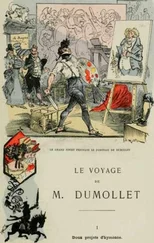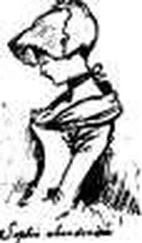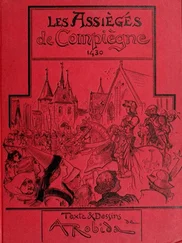Albert Robida - Yester-year; ten centuries of toilette from the French of A. Robida
Здесь есть возможность читать онлайн «Albert Robida - Yester-year; ten centuries of toilette from the French of A. Robida» весь текст электронной книги совершенно бесплатно (целиком полную версию без сокращений). В некоторых случаях можно слушать аудио, скачать через торрент в формате fb2 и присутствует краткое содержание. Жанр: Старинная литература, на английском языке. Описание произведения, (предисловие) а так же отзывы посетителей доступны на портале библиотеки ЛибКат.
- Название:Yester-year; ten centuries of toilette from the French of A. Robida
- Автор:
- Жанр:
- Год:неизвестен
- ISBN:нет данных
- Рейтинг книги:4 / 5. Голосов: 1
-
Избранное:Добавить в избранное
- Отзывы:
-
Ваша оценка:
- 80
- 1
- 2
- 3
- 4
- 5
Yester-year; ten centuries of toilette from the French of A. Robida: краткое содержание, описание и аннотация
Предлагаем к чтению аннотацию, описание, краткое содержание или предисловие (зависит от того, что написал сам автор книги «Yester-year; ten centuries of toilette from the French of A. Robida»). Если вы не нашли необходимую информацию о книге — напишите в комментариях, мы постараемся отыскать её.
Yester-year; ten centuries of toilette from the French of A. Robida — читать онлайн бесплатно полную книгу (весь текст) целиком
Ниже представлен текст книги, разбитый по страницам. Система сохранения места последней прочитанной страницы, позволяет с удобством читать онлайн бесплатно книгу «Yester-year; ten centuries of toilette from the French of A. Robida», без необходимости каждый раз заново искать на чём Вы остановились. Поставьте закладку, и сможете в любой момент перейти на страницу, на которой закончили чтение.
Интервал:
Закладка:
The fluttering gowns allowed the legs to be seen, or even, when not slit open at the side, were raised above the knee, and, fastened with a cameo brooch, boldly displaying the left leg. Very little sleeve was worn, a mere strap, or even no sleeves at all, the edges of the gown were drawn together by cameos on the shoulders, and the arms were laden with bracelets.
As it was impossible to put pockets into these flimsy tunics, the ladies adopted the use of the 'balantine,' or 'reticule'' (which was immediately pronounced ' ridicule '), an old name for a little bag ornamented with spangles or embroidery, and shaped like a hussar's
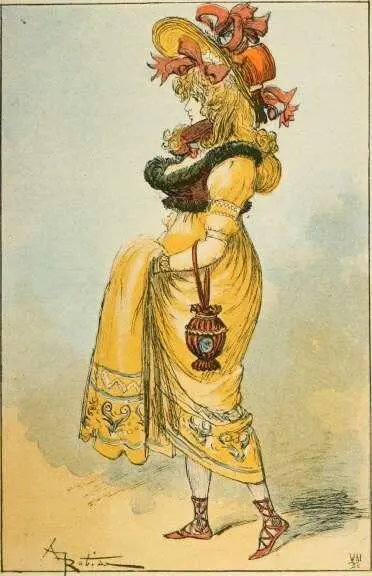
MERVEILLEUSH DU DIRECTOIRE.
sabretaclie ; iu this the handkerchief and jturse were carried, Jacob tlie Bibliophilist rehites that on a certain evening, in a fashionable salon under the Directory, everybody being eloquent in admiration of a costume so truly antique that nothing except the mode of the Garden of Eden could be more so, the fortunate wearer laid a wager that it did not weigh two pounds. Proof was given, the lady retired into a boudoir, and her entire costume with the trinkets was found to weigh little over one pound.
This neo-Athenian dame might count herself very much dressed, for others found means to be still less encumbered with clothes, and actually ventured to exhibit themselves in a costume called ' The female Savage,' which consisted solely of a gauze chemise over pink fleshings with golden garters.
Women actually walked in the Champs-Elysées in ' sheaths ' almost entirely transparent, or even with the bosom completely bared, and these women were not courtesans.
but belonged to tlic otficial ' woiiJ ' of the day, and were friends of Joséphine de Beauharnais.
This was thoughtlessness rather than immodesty, a jDassing fit of insanity, the delirium of pleasure after furious madness and the delirium of blood !
The ' Merveilleuses,' who had defied the guillotine, also defied disease. Nevertheless, many of these foolish half-naked women were seized witli pleurisy and inflammation of the lunos on leavinjf crowded ball-rooms and salons, after dancing, with no more protection from the cold of the night than a thin fichu or a shawl no larger than a scarf. Having taken their costume fashions from Athens, these semi-draped fine ladies borrowed their head-dresses from Greek statues, and wore their crisply-curled hair in a net, the tresses and plaits having jewels inserted in them. But the ' rage ' was for fair-haired wigs. Mme. Tallien had thirty, of every shade of light hair. These wigs, which were sliglitly powdered, had been abhorred and proscribed by the Jacobins; after Thermidor came their tiiiniiph, the 'peruke blonde' was thenceforth a symbol of the coimter-revolution.
For a while hair was dressed ' à la Victime,' or ' à la Sacrifiée ; ' being combed up at the back and brouglit forward on the forehead in wild locks. This gu-illotine style of headdress, with a blood - red ribbon round the neck, and a shawl of the same colour on the shoulders, was indispensable for all those who appeared at the famous and ghastly ' Bal des Victimes/ to which neitlier man nor woman was admitted who could not prove that either of his or her parents, or some near relation, had died upon the scaffold in the Terror.^
"Paole d'honneu victimée, ces dames sont déliantes!" said the 'Incroyables,' in the fashionable slang, and with the lisp à la mode, to each new invention, more 'delicious' and more ' antique ' than the preceding, of Mme. Nancy and Mme. Raimbout, a pair of learned and artistic dressmakers, who employed sculptors to assist them in devising methods of draping ^ See nute, Appendix, p. 264. more and more Greek, and folds increasingly Roman.
Roman fashions, wliicli were somewhat less light and loose, were adopted by ladies who shrank from the too literal transparency of the Flora and the Diana tunics.
Roman gowns w^ere worn by the ladies of the official world, who considered themselves bound to exercise a certain discretion, but the two worlds effected a fusion. Light and frivolous ' Athenians,' remains of the old and parvenus of the new society, army contractors or suddenly enriched speculators, ' muscadins ' and ' muscadines,' victims and persecutors, gilded youth, the army, politics, and finance, all these formed the most marvellous of mixtures after the great shock, and rejoiced in the happiness of living after the great slaughter, notwithstanding the troubles of the present, and the uncertainty of the future.
A sudden decree of fashion put an end to the fair wigs, and imposed the ' Titus ' on all women with any pretensions to a place in its ranks. The Directory belles threw away their perukes, and also sacrificed their own locks. No more hair, or at any rate as little as possible !
" The Titus mode," says La Mosangere in Lc hon Genre, the official organ of Fashion, "consists in havinsf the hair cut close to the
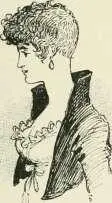
Titus Coiffure.
roots, SO as to restore its natural stiffness to the tube, and make it grow in a perpendicular direction." 'Merveilleuses' and 'Muscadins' each and all adopted the 'Titus,' and were closely shorn, a few long dishevelled locks being allowed to hang over the brow.
There was yet another type of ' Merveilleuses ' under the Directory. This was the 'Merveilleuse à la Carle Vernet/ still lightly clothed, still squeezed into a thin clinging skirt of 'Fie ! Fie ! pale startled' colour/ but wearing above her bodice (which was so small as to be almost invisible), and above her naked bosom, a formidable cravat, in whose folds her neck was enveloped several times, precisely like the muscadin's, while from beneath her huge plumed hat long locks of hair hunsc like dock's ears about her face.
Such was the attire and the head-dress of beaux and belles at the dawn of our century. During the Consulate and the first years of the Empire, the ' Merveilleuses ' were a little, but not much, more clothed than under the Directory. The same gowns, frequently transparent, continued to be worn, necks continued to be bared to excess in all seasons. The women of that time went out walking in tlie day, as the women of our time go to balls, 1 Fifi pâle efFarouclie.
with their bosoms and arms exposed. Their defence against cold consisted of scarfs and shawls — the forerunners of those famous

Under the Consulate.
' Cachemires,' which played so great a part in the first half of the century.
Special garments were invented, such as the little hussar vest, in 1808, which was put on over the low-necked bodice, and encircled the shoulders with its fur border, also the far less becoming spencer.
The celebrated portrait of Joséphine de Beauharnais by David, and that of Mme. Récamier by Gerard, shew us two beautiful Roman women of the time of the Emperors, reclining upon couches in the antique style, rather than Frenchwomen of less than one hundred years ago. Such however was the costume of the beauties of the salons of the Directory, those fair Parisians who crowded round Garat while he sang his ' romances,' or danced the gavotte, or the waltz, then the very newest novelty, with the handsome Trénitz.
In 1803, or 1804, the 'Titus' style of hair-dressing had ceased to be fashionable, it was ' old,' it was ' provincial.' And what of the hair that was not to be hurried into crrowins long again, immediately upon the change of taste ? The ladies bemoaned their luxuriant locks, fair, brown, or auburn, and were obliged
Читать дальшеИнтервал:
Закладка:
Похожие книги на «Yester-year; ten centuries of toilette from the French of A. Robida»
Представляем Вашему вниманию похожие книги на «Yester-year; ten centuries of toilette from the French of A. Robida» списком для выбора. Мы отобрали схожую по названию и смыслу литературу в надежде предоставить читателям больше вариантов отыскать новые, интересные, ещё непрочитанные произведения.
Обсуждение, отзывы о книге «Yester-year; ten centuries of toilette from the French of A. Robida» и просто собственные мнения читателей. Оставьте ваши комментарии, напишите, что Вы думаете о произведении, его смысле или главных героях. Укажите что конкретно понравилось, а что нет, и почему Вы так считаете.

